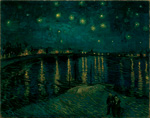Vincent van Gogh Exhibition, Amsterdam
Huon Mallalieu is illuminated by the van Gogh exhibition in Amsterdam


For most people, the reaction conjured up by the words van Gogh is probably ‘yellow’, as in sunflowers and parched walls and wheat fields under a southern sun. For him, however, the lesser luminaries of the night, the Moon and stars, were as important as the Sun; indeed, in 1888, he noted: ‘It often seems to me that the night is much more alive and richly coloured than the day.’ That is the theme of ‘Van Gogh and the Colours of the Night’, the first collaboration between the Van Gogh Museum and MoMA, which opened in New York and is on in Amsterdam from this week.
The New York show had one great pleasure not available in Europe the chance to see from one spot The Starry Night over the Rhone and The Night Café, 1888, plus The Starry Night, 1889, three of the artist’s greatest works. The Night Café could not travel to Europe. (On another occasion, I would love to see it hanging with Hopper’s Night-hawks.) But even without it, this is a powerfully moving show, and I found myself really enjoying van Gogh’s paintings where previously his drawings had meant more to me.
Given the brevity of his career essentially a decade it is fascinating to realise just how much of his work is informed by the night, or by the twilight at either end of it. It was the time that he most liked to work, to reflect on himself and the past day. He associated it with security and poetry, and it was natural that the resultant paintings should combine reality and symbolism, factual observation and imagination.
The show is not large, but it packs in a great deal. It opens with early drawings and paintings of dank Dutch landscapes that capture the melancholy of dusk. Links to the 17th century, particularly Rembrandt and Ruisdael, and the influence of Corot are evident, as they are again in the scenes of peasant life and studies of sowers and wheat fields in the evening light.
The core of the exhibition is ‘Poetry of the Night’, subdivided into sections on the town and the country. Like the sowers, these are products of the south, after van Gogh’s move to Arles in 1888, and the colours reflect that, although a further strong element is his enthusiasm for Japanese woodblock prints, acquired during two years in Paris. Although he was happy with The Starry Night over the Rhone, he was not content with his later The Starry Night, painted in the asylum, which he regarded as a study. That, too, is now accounted a true masterpiece, and it is a wonderful expression of the vertiginous effect of drowning upwards in a clear night sky.
‘Van Gogh and the Colours of the Night’ is at the Van Gogh Museum, Amsterdam, from February 13 to June 7 (020–570 5200; www.vangoghmuseum.com/night
Sign up for the Country Life Newsletter
Exquisite houses, the beauty of Nature, and how to get the most from your life, straight to your inbox.
Country Life is unlike any other magazine: the only glossy weekly on the newsstand and the only magazine that has been guest-edited by HRH The King not once, but twice. It is a celebration of modern rural life and all its diverse joys and pleasures — that was first published in Queen Victoria's Diamond Jubilee year. Our eclectic mixture of witty and informative content — from the most up-to-date property news and commentary and a coveted glimpse inside some of the UK's best houses and gardens, to gardening, the arts and interior design, written by experts in their field — still cannot be found in print or online, anywhere else.
-
 About time: The fastest and slowest moving housing markets revealed
About time: The fastest and slowest moving housing markets revealedNew research by Zoopla has shown where it's easy to sell and where it will take quite a while to find a buyer.
By Annabel Dixon
-
 Betty is the first dog to scale all of Scotland’s hundreds of mountains and hills
Betty is the first dog to scale all of Scotland’s hundreds of mountains and hillsFewer than 100 people have ever completed Betty's ‘full house’ of Scottish summits — and she was fuelled by more than 800 hard boiled eggs.
By Annunciata Elwes